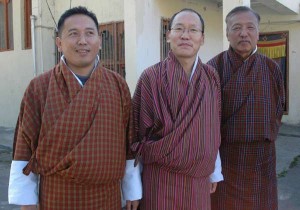Bhutan panic in Darjeeling hills
A delegation from the Ministry of Home and Cultural Affairs recently returned to Thimphu from its Darjeeling and Kalimpong trip assessing the situation of Bhutanese students who are pursuing their higher education in this hilly town.
The ministry was concerned about the students after the Gorkha Janamukti Morcha (GJM), the agitating political party for a separate state in the hills, imposed compulsory use of ethnic dress for all students there.
The GJM had prescribed the dress code early this year for general residents. With the announcement, most hill residents began revising their traditional dresses – gunyu-cholo for females and daura-suruwal-topi for males. Bhutanese students boycotted it.
In early October, the party announced that all students must adhere by the prescribed dress code. Bhutanese students studying in various colleges here again rejected the call saying it was not their cultural or ethnic dress. In several occasions, the Bhutanese students, who prefer pant-short over gho and kira in Darjeeling and Kalimpong, submitted letters to the local leaders of GJM and their alliance urging them not to impose the dress code for Bhutanese.
Seeing that all those residents, especially from Bhutan, did not adhere by the order, the GJM cadres have been mobilized in most schools and colleges to monitor to ensure that the students come with the Nepali (rather Gorkhali) dress to study. All those not abiding by the rule were returned from school and college gates.
The panic penetrated throughout the Bhutanese students and it invited emotional fright to their parents. Compulsion to wear a dress that is not traditionally their, is beyond assumption and tolerance. The pains in heart rule so much for the Bhutanese students that it certainly cannot be translated into words, cannot be expressed in voices.

Meghraj Gurung (right), a council member of Center for Bhutan Studes (CBS) obeys order for wearing local dress
Not aware of the political freedom, right to protests and right to wear any dress as enshrined by the universal principal of human rights, Bhutanese students in Darjeeling and Kalimpong have gone through mental stress and psychological torture. The only option for them is to appeal the agitators.
In fact, primary reasons lie elsewhere. Wearing gunyu-cholo and daura-suruwal is not unfitting for Bhutanese students. It is rather a hatred that Bhutanese society inculcated in them as they grow up. The hatred to this Nepali-dress had reached a peak when Nepali-speaking population opposed the government decision in Bhutan in late 1980s to make gho-and kira as compulsory dress, even in field for the Nepali-speaking population who live in tropical south.
The Bhutanese authorities have already started lobbying the parents to transfer their children to other schools in India if GJM continues to impose the dress code. The Bhutanese authorities have instructed them, indirectly, not to adhere by the dress code as it is not their cultural wear. The hatred continues…
The panic and psychological torture that Nepali-speaking population undergone since 1980s in Bhutan must have been reflected in the hearts of the Bhutanese rulers for now. For decades, Bhutanese rulers did not show any concern on panic that Nepali-speaking southern Bhutan citizens tolerated due to imposition of dress of other ethnic group. The driglam namzha code is still in effect in Bhutan.
The Darjeeling-Kalimpong incident is a minor case. The GJM has not compelled the Bhutanese to follow Hindu rituals and culture. The extent of panic that Bhutanese rulers might feel this time is beyond imagination if the GJM made it compulsory for a certain specific rituals and cultures to be followed by the resident in Gorkhaland hills copying the ideas unveiled by Bhutan some two decades ago.
In fact, the ‘one nation one people’ policy is stricter than this minor imposition of gunyu-cholo-daura-suruwal in Gorkhaland. The Gorkha move is not only for protecting ethnic identity in democratic India but also to teach the tyrants in Bhutan that such imposition has limits to tolerate.
Attachment to culture in which one born cannot be explained in words. Bhutanese leaders must understand this. Learning lessons from the panic they endured by GJM imposition, the government in Bhutan has good opportunity to revise its policy on dress code.

